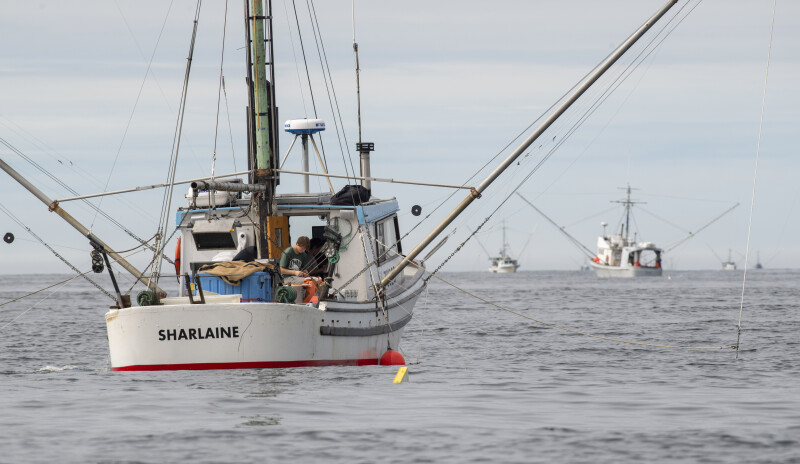Alaska, one of the world’s premier seafood producers, is dealing with a raft of legal and administrative challenges with potential to hobble or close fisheries and gut the state’s management authority.
“Alaska fisheries are besieged on many fronts,” said Alaska Fish and Game Commissioner Doug Vincent-Lang in an interview with National Fisherman.

His department, its lawyers, and fishery managers are straining to defend Alaska’s fisheries in courts and other forums.
One of the biggest challenges is a petition from a Washington state group, the Wild Fish Conservancy, to list Gulf of Alaska Chinook salmon under the Endangered Species Act.
While Chinook returns certainly have weakened around Alaska in recent years, state officials say no Chinook stocks are currently threatened with extinction. It came as a shock to the state government, and to many Alaskans overall, when the National Marine Fisheries Service in May issued what’s known as a 90-day finding on the petition that a listing “may be warranted.”
The agency said it was commencing a review of the status of the Gulf of Alaska Chinook, and it opened a public comment period that wrapped up on Sept. 6. Dozens of comments poured in from commercial and sport fishing associations, tribal organizations, conservation groups, and others. They generally opposed listing Chinook as threatened or endangered, citing potential economic and cultural harm. Petersburg, an important commercial fishing port, was among those warning such an action “would transfer the management of the listed salmon and their critical habitats from the state of Alaska to the federal government.” The Alaska Department of Fish and Game, in its extensive written comments, flatly called upon NMFS to withdraw its “inappropriate” finding.
In the courts, major fisheries lawsuits are raging.
One case, brought in 2020 by the Wild Fish Conservancy, seeks to halt the Southeast Alaska troll fishery, which the group contends is depriving endangered killer whales of food. On Aug. 16, the 9th U.S. Circuit Court of Appeals in San Francisco issued an opinion allowing the fishery to continue as NMFS completes a new “biological opinion.” It was a big victory for fishery managers and trollers, but the legal battle likely is far from over, as Vincent-Lang explains in our interview.
Another long-running case involves the Metlakatla Indian Community’s efforts to greatly expand the scope of its Southeast Alaska fishing rights. If the Metlakatlans prevail, it would blow a large hole in the state’s system of requiring permits as a means of regulating participation in salmon and other fisheries.
Two other weighty court cases focus on ecosystem change and bycatch in Alaska’s huge Bering Sea groundfish trawl fisheries. One case potentially could halt the enormous pollock fishery. The other case, brought by the 17-vessel Groundfish Forum fleet, argues a newly implemented halibut bycatch control program is financially ruinous. The state’s position is these issues are best handled by the North Pacific Fishery Management Council, not the courts, Vincent-Lang said.
On other fronts, Alaska salmon fisheries are facing objections to their Marine Stewardship Council certification. And a broad seafood market slump has necessitated formation of a legislative task force to evaluate the industry crisis.
All these issues are placing extraordinary pressure on the state and industry.
Vincent-Lang has been Alaska’s fish and game commissioner since December 2018. He agreed to field a few questions on the rough seas currently pounding the state.
Q: Alaska fisheries seem besieged with complex legal and administrative challenges. Does the Department of Fish and Game have adequate attorneys and other resources to meet these challenges? Has the department perhaps needed to bring in outside counsel?
A: You are correct, Alaska fisheries are besieged on many fronts – from unfair Marine Stewardship Council certification processes, to unfair trade policies and a global seafood market collapse, to high operational costs. On top of this, we are facing administrative challenges such as the National Marine Fisheries Service's decision to conduct an Endangered Species Act status review on Gulf of Alaska Chinook salmon, requests to alter our fisheries for beluga whales and other marine mammals, and administrative challenges to our authority to manage. Finally, we are the target of various legal challenges to our fisheries both at the state and federal levels.
All of these take resources to address. For example, to respond to the ESA Chinook salmon status review, I have had to redirect staff and fiscal resources to ensure NMFS had the best available data to inform their decision. We are also legally engaged to defend our rights to manage. All of this takes resources. Could we use more? Certainly, but we will continue our participation in these forums, given the importance of fisheries to Alaskans and our economy.
Q: Why is the Metlakatla case so important to the state? And what’s your view of the U.S. Department of Justice siding with Metlakatla?
A: In the Metlakatla case, the question is whether the Metakatlans have the right to commercially fish outside of the Annette Islands Reserve in Southeast Alaska waters without a valid limited entry permit. The right to commercially fish without state regulation within the Annette Islands Reserve – land and water Congress granted to the Metlakatlans in 1891 – is not being questioned. However, the state asserts that the 1891 act that created the Annette Islands Reserve did not grant the Metlakatlans a superior commercial fishing right – a right whereby the Metlakatlans are not subject to the state’s limited entry permit program. We believe that the state of Alaska’s commercial fishing statutes and regulations apply to all commercial fishermen, including the Metlakatlans. We have a responsibility to ensure the longevity and productivity of Southeast Alaska’s fisheries. As such, we will defend our right to manage these waters under state laws and regulations. We were disappointed with the decision of the U.S. Department of Justice entering into this lawsuit, because we believe they are ignoring a long list of management complications should the Metlakatlans be found to hold a superior fishing right over other Alaskans who commercially fish in Southeast Alaska’s waters.
Q: Any possibility of a settlement in the Metlakatla or other fisheries cases now pending?
A: In a case where a party is asserting a superior fishing right over all other commercial fishermen – which directly conflicts with the “no exclusive right of fishery” language in Article VIII, Section 15 of the Alaska Constitution – it is hard to envision what settlement looks like. Nevertheless, we remain open to meaningful dialogue.
Q: The troll fishery recently scored a major victory in the 9th U.S. Circuit Court of Appeals. This doesn’t mean the case is over, however. What do you anticipate next? Can the state now count on NMFS to support keeping the fishery open?
A: We expect NMFS to issue their revised NEPA (National Environmental Policy Act) and biological opinion documents later this year. It is our belief that these documents will address the issues identified by the court. This said, the issuance of these documents restarts the potential for another legal challenge. We fully expect that new legal challenges will be initiated once the new documents are released. It is our hope that NMFS will defend the newly issued documents with vigor.
Q: The Wild Fish Conservancy has petitioned to list Gulf of Alaska Chinook salmon as threatened or endangered, and NMFS has found that a listing may be warranted. What’s the state’s position on this? Are any Gulf Chinook stocks actually threatened or endangered?
A: We are deeply disappointed in the decision by NMFS to issue a positive 90-day finding. The petition was clearly drafted by people with little knowledge of Alaska and Alaska salmon stocks. It was rife with significant factual errors, omits important data that are widely available, and does not accurately describe the status of Chinook salmon in Alaska. It is mind-boggling that NMFS could make a positive finding based on cherry-picked data to support a predetermined viewpoint. We are concerned that this decision will encourage more frivolous petitions in the future.
The ESA is the wrong tool to address a downturn in Chinook productivity. Simply failing to meet an escapement goal that is calculated to meet maximum sustained yield does not mean a stock is at risk of extinction. As the resource manager, the Alaska Department of Fish and Game is both constitutionally obligated and committed to sustainable fisheries management. The state has taken aggressive management measures to conserve these stocks which have been proving successful. The state does not believe that any Gulf of Alaska Chinook salmon stocks are threatened with extinction now or in the foreseeable future.
Q: Two cases now pending in Alaska federal court – Association of Village Council Presidents and Tanana Chiefs Conference v. NMFS and Groundfish Forum v. NMFS – address the huge groundfish fisheries off Alaska and bycatch of salmon and halibut. What’s the state’s position on these cases?
A: The first case asserts that NMFS did not fully analyze the impacts of recent environmental changes when approving total allowable catch limits for all federal groundfish fisheries in the Bering Sea. The state actively participates in and supports the annual process to review stock assessments and set sustainable catch limits for all federally managed species, which includes consideration of ecosystem changes. However, improvements can always be made, and we believe this is best done through ongoing efforts at the North Pacific Fishery Management Council to better incorporate uncertainty from climate change and other factors into the federal fishery management process.
The second case challenges establishing an abundance-based halibut bycatch management program in the Bering Sea.
Bycatch is a contentious issue. The state recognizes this and is taking steps to reduce bycatch to the extent practical and allowable under federal laws. At the council, we led the effort to adopt the abundance-based halibut bycatch reduction program and support the defense of that program from legal challenge. On the salmon front, we support the council's enactment of abundance-based Chinook salmon bycatch caps and have worked with industry to maintain actual bycatch levels significantly below the caps. And we are addressing chum salmon bycatch to minimize the intercept of Arctic-Yukon-Kuskokwim chum salmon.
We are also continuing efforts to implement recommendations from the governor’s Bycatch Review Task Force, both at the state and federal level. Finding the right balance between bycatch and groundfish fishing is challenging given the importance of groundfish harvests to Alaska residents and communities, but I am confident that we will continue to find ways to reduce bycatch.







